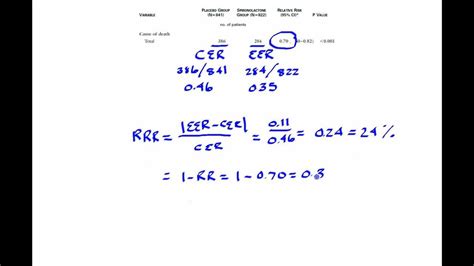The Absolute Risk Reduction (ARR) formula is a crucial metric in epidemiology and clinical research, used to quantify the difference in risk of a particular outcome between two groups, such as a treatment group and a control group. Understanding and applying the ARR formula is essential for clinicians, researchers, and policymakers to make informed decisions about the effectiveness of interventions and treatments.
Introduction to Absolute Risk Reduction

Absolute Risk Reduction is defined as the absolute difference in the risk of an event (such as a disease or adverse outcome) between a treatment group and a control group. It is an important measure because it provides a clear indication of the effectiveness of an intervention in reducing the risk of a specific outcome. The ARR formula is often used in conjunction with other metrics, such as the Relative Risk Reduction (RRR) and the Number Needed to Treat (NNT), to provide a comprehensive understanding of the benefits and risks associated with a particular treatment or intervention.
ARR Formula and Calculation
The Absolute Risk Reduction formula is calculated as follows: ARR = Risk in the control group (Rc) - Risk in the treatment group (Rt). This formula can be expressed mathematically as: ARR = Rc - Rt. For example, if the risk of a particular disease in the control group is 20% (Rc = 0.20) and the risk in the treatment group is 12% (Rt = 0.12), the ARR would be 0.20 - 0.12 = 0.08, or an 8% absolute reduction in risk.
| Risk Group | Risk Value |
|---|---|
| Control Group (Rc) | 20% (0.20) |
| Treatment Group (Rt) | 12% (0.12) |
| Absolute Risk Reduction (ARR) | 8% (0.20 - 0.12) |

Interpretation and Application of ARR

The interpretation of ARR is straightforward: it represents the proportion of individuals who, thanks to the intervention, will not develop the outcome of interest. For instance, an ARR of 8% means that for every 100 individuals treated, 8 fewer will develop the disease compared to if they had not received the treatment. This metric is particularly useful for clinicians and policymakers because it helps in assessing the potential impact of an intervention on a population level.
Limitations and Considerations
While the ARR is a valuable metric, it has its limitations. One of the primary considerations is that ARR does not provide information on the baseline risk of the population. Interventions that may seem highly effective in terms of ARR in a high-risk population may appear less effective in a low-risk population, even if the relative risk reduction is the same. Therefore, it’s essential to consider ARR in conjunction with other metrics, such as NNT and RRR, to get a comprehensive view of an intervention’s effectiveness.
Key Points
- The Absolute Risk Reduction (ARR) formula calculates the difference in risk between a treatment and control group.
- ARR is essential for understanding the effectiveness of interventions and treatments.
- The formula is ARR = Risk in the control group - Risk in the treatment group.
- ARR should be considered alongside other metrics like Relative Risk Reduction (RRR) and Number Needed to Treat (NNT).
- Understanding ARR is crucial for informed decision-making in clinical practice and policy development.
Real-World Applications and Implications
In real-world scenarios, the ARR has significant implications for public health policy, clinical practice, and patient decision-making. For instance, in the context of preventive medicine, an intervention with a small but significant ARR could be highly beneficial when applied to a large population, even if the NNT is high. This is because the absolute number of cases prevented could be substantial, leading to considerable public health benefits.
Forward-Looking Perspectives
As the field of epidemiology and clinical research continues to evolve, the importance of metrics like ARR will only grow. With advancements in data analysis and the increasing availability of large datasets, researchers will be able to calculate ARR with greater precision and apply it to a wider range of scenarios. This could lead to more targeted and effective interventions, ultimately improving health outcomes and patient care.
What is the primary use of the Absolute Risk Reduction formula in clinical research?
+The primary use of the Absolute Risk Reduction (ARR) formula is to quantify the difference in risk of a particular outcome between a treatment group and a control group, providing a clear indication of the effectiveness of an intervention.
How does ARR differ from Relative Risk Reduction (RRR)?
+ARR measures the absolute difference in risk, while RRR expresses the reduction in risk as a proportion of the original risk. Both metrics are complementary and provide different insights into the effectiveness of an intervention.
What are the limitations of using ARR alone to assess the effectiveness of an intervention?
+ARR does not account for the baseline risk of the population. Therefore, it should be used in conjunction with other metrics like RRR and NNT to get a comprehensive view of an intervention's effectiveness.
In conclusion, the Absolute Risk Reduction formula is a powerful tool in the assessment of treatment effectiveness and risk reduction. By understanding and applying ARR, clinicians, researchers, and policymakers can make more informed decisions about interventions, ultimately leading to improved patient outcomes and public health benefits. As the field continues to evolve, the integration of ARR with other metrics will remain essential for a nuanced understanding of health interventions.



